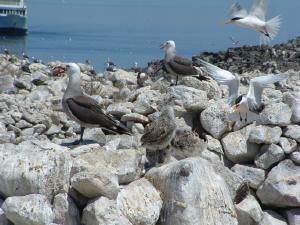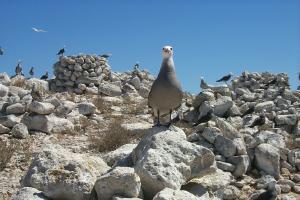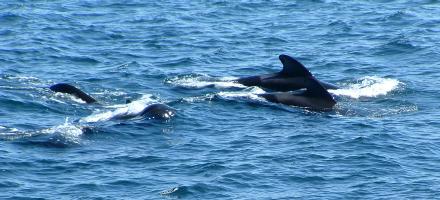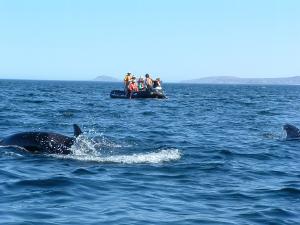Day 4: Isla Rasa and Pilot Whales

|
| Hills at Sunrise
|
After giving Ged (pronounced Jed) a hard time about waking us up so early yesterday he woke us up 15 minutes earlier this morning (6:35). But with good reason since they had spotted 4 fin whales once again off the port side so that all we had to do was walk out of the room. Though the fin whales are not real exciting to watch since they don't come up above the waves very far, never raise their tails above water, and stay down for a long time, by having more of them you didn't have to wait as long to see the next one. One of them came up kind of suddenly and we could see his mouth. They also put on a pretty good show by spouting high and usually 4 times or so before diving again.

|
| Gull With Twins
|
After that we had breakfast, went to a lecture on desert plant adaptations by William, and prepared for our trip to Isla Rasa where thousands of Heermann's Gulls and Elegant Terns nest. The eggs hatched a few weeks ago so we were able to see their young.
We had to wait until high tide because there is a very shallow inlet that is only navigable by zodiacs when the tide is way up.
There is constant activity as the birds fly out to sea and come back to bring food to their youngsters. It's like a scene from Star Wars where all the ships are coming to and leaving the death star.

|
| Terns and Gulls Conflict
|
The Heermann's Gulls are very territorial, staking out their same little spot every year, even years when they don't nest so that nobody else will move in. Once their spot is established they will defend it and would loudly mew at any human trespassers though they will flat out attack wandering gulls or stray babies. This way they can return to that spot once they get food and their baby will be there waiting for them. Enriquetta is a researcher who has studied the bird colony here for 20 years from a time when their population was decimated by egg collectors and rats to now when she has eradicated the rats and stopped poaching. Ged said they used tubes that only rats could fit down with poison inside to kill off the rats and there is no evidence of rats or mice anymore. When guano collecting was a big deal, the collectors came and shovelled it all out, stacking the rocks they came across. Now there are piles of rocks all over the island, but not as much guano as you would expect. Some of the rock piles provide good shade for the babies during the day. Other babies sit in the hot sun with their mouths open trying to stay cool.

|
| Gull and Rock Cairns
|
The elegant terns also nest here but are not territorial. Still they compete with the gulls for space. The terns are very afraid of humans and will move out of the way of approaching humans, leaving their eggs or babies in danger of attack by predators or gulls looking for space to claim. One person wandering around the island can throw everything out of balance but we were allowed to get a close look nonetheless.
Enriquetta came aboard the boat and gave a lunchtime talk to us. She also got to shower and get a good meal, bringing a few of the students who help her out as well. She said that there is one pair of peregrine falcons that lives on the island (Susan says I'm wrong about this and the falcons commute to work from another island). The falcons are very territorial so they don't share the island with any other falcons. That's good news for the gulls and terns since it means there are fewer predators. Maybe there's a reason to why all the birds go to this one island. She said that birds who lose an egg and then mate again are at a disadvantage to predators because there will be much smaller numbers by July 1 when the main crop of birds flies away.
After the siesta the announcement came over the loudspeaker that pilot whales had been spotted off the port side. Susan and I were already out on the bow.

|
| Fin Whale
|
There were many black torpedo shaped pilot whales on their way north as we were heading south. They stretched in a long front across the water porpoising and occasionally making more impressive breaching or fluking moves.
Soon after a fin whale was also sighted and it was hard to decide whether to look at the pilot whales to port or starboard or check out the fin whale. The fin whale suddenly surfaced just off the port bow. Then he went below the surface but we could make out his entire length as he passed just under the bow. At that close range you could see through the water to the white colorations on his side and tail. One of the naturalists said he was 70 feet long.
After the fin whale disappeared our attention focused back on the pilot whales which now appeared to number in the hundreds. Ged ordered the zodiacs to be lowered and everyone lined up to get on board and go meet the pilot whales. Susan and I got on the third zodiac to be released and we headed off into the school of whales. They were incredible as they would surface just next to the boat and one smacked his tail and splashed some people on the front. When they surfaced close by you could see scars on their skin. The rubbery black skin looked like it was made of zodiac material.

|
| Pilot Whales
|
With whales all around it was hard to pick a spot to point the camera. After about an hour of following the whales some of us were ready to get back to the boat where celebratory cocktails awaited us. Susan and I hung out with the other old people who had gotten tired of the chase or had never gone while we continued to see whales around the boat and the zodiacs in the midst of them. This continued for about another hour before everyone came back very excited and animated. After a talk about pilot whales we all headed to dinner and conversation was definitely livelier than it had been in previous nights and people stayed behind after dinner. Ged said that by the time we finished following the whales northward we were almost back to Isla Rasa so we didn't get to snorkel. I don't think we were really harassing the whales because for a while we were stopped completely and they were staying around. The whales seemed to know to stay below the surface when crossing under the zodiacs. Some of the groupings were obviously families with larger males, smaller females, and some much smaller babies bobbing along with them.
I used up a lot of digital film today and only got a few really stunning pictures. I'm counting on the ship's videographer to have caught some of the excitement. It's only Tuesday.

|
| Pilot Whales with Zodiac
|







